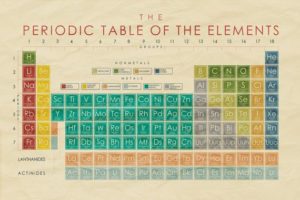
“The periodic table is arguably the most important concept in chemistry” – Peter Atkins, chemist.
This month (March) marks a huge anniversary for chemists and chemistry lovers all over the world. 150 years ago, Russian chemist Dmitrii Ivanovich Mendeleev created the periodic table of the elements.
Mendeleev’s table has become a staple not only in our lab, but in the very science behind what we do here at SGS The periodic table summarizes an entire science into small squares containing letters and numbers that have become our lifeblood. It enumerates the elements and arranges them according to their properties, guiding chemical research both in theory and in practice.
Some say that Mendeleev conceived and created his table in a single day: March 1, 1869. As the legend goes, Mendeleev had been thinking about grouping the known elements for years. He, along with other chemists, knew links existed between atomic weights and chemical properties. However, it wasn’t until the 1860s that atomic weights had been well enough understood and measured.
As a professor at the University of St. Petersburg, Mendeleev was asked to teach inorganic chemistry. While preparing to master the field, he was not enlightened by the available text on the subject and decided to write his own. While organizing the text, he wanted to also organize the elements. The only question was: How best to arrange them?
By early 1869, Mendeleev had made enough progress on his book to realize that some groups of similar elements showed a consistent increase in atomic weights. He also realized that some elements with roughly equal atomic weights shared common properties.So ordering the elements by their atomic weight was his key to categorizing them. To keep them straight and organized, Mendeleev wrote each of the 63 known elements’ properties on an individual piece of paper. Then, he arranged the cards in vertical columns from lower to higher atomic weights, and placed elements with similar properties in each horizontal row.
And voilà: Mendeleev’s periodic table was born.
He sketched out his table on March 1, sent it to the printer and incorporated it into his soon-to-be-published textbook. He also prepared a paper to be presented to the Russian Chemical Society that same year.
Maybe even more impressive than creating the table in a day, was Mendeleev’s ability to predict undiscovered elements. During the preparation of his table with 63 elements, Mendeleev noticed that some spots were missing. He left blank spaces to be sure the known elements were properly aligned. Before Mendeleev’s death in 1907, 3 of those blanks were filled with the elements gallium, scandium and germanium. Not only had Mendeleev predicted the existence of these elements, but he had also correctly described their properties in detail.
Within the last 150 years, hundreds if not thousands of versions of the periodic table have been devised and published. The modern form as we know it (a horizontal design instead of Mendeleev’s original vertical design), became widely popular after World War II, largely due to the work of the American chemist Glenn Seaborg. Seaborg and his colleagues were responsible for discovering many new elements, including element 101. In 1955, Seaborg named the element “mendelevium”, for the chemist who above all others deserved a place at the periodic table.
For Prop 65 testing of metals in your product, please contact Chemical Solutions either by calling us at (717) 697 –7536 or submitting a request. Either way, we’ll respond promptly to your inquiry.



